Remote Detection of Uranium Using Self-Focusing Intense Femtosecond Laser Pulses
Abstract
1. Introduction
2. Libs Using Ultrashort Laser Pulses
3. Nonlinear Effects in Free Beam Propagation
4. Experiment
5. Results and Discussion
5.1. Uranium Spectrum
5.2. Chirp Optimization
5.3. Remote Detection
6. Conclusions
Author Contributions
Funding
Conflicts of Interest
References
- Schneider, S.; Walther, C.; Bister, S.; Schauer, V.; Christl, M.; Synal, H.A.; Shozugawa, K.; Steinhauser, G. Plutonium release from Fukushima Daiichi fosters the need for more detailed investigations. Sci. Rep. 2013, 3, 2988. [Google Scholar] [CrossRef]
- Katz, S.A. The Chemistry and Toxicology of Depleted Uranium. Toxics 2014, 2, 50–78. [Google Scholar] [CrossRef]
- Chinni, R.C.; Cremers, D.A.; Radziemski, L.J.; Bostian, M.; Navarro-Northrup, C. Detection of Uranium Using Laser-Induced Breakdown Spectroscopy. Appl. Spectrosc. 2009, 63, 1238–1250. [Google Scholar] [CrossRef] [PubMed]
- Kim, D.; Yu, D.; Sawant, A.; Choe, M.S.; Lee, I.; Kim, S.G.; Choi, E. Remote detection of radioactive material using high-power pulsed electromagnetic radiation. Nat. Commun. 2017, 8, 15394. [Google Scholar] [CrossRef]
- Cremers, D.A.; Radziemski, L.J. Handbook of Laser-Induced Breakdown Spectroscopy; John Wiley & Sons: Hoboken, NJ, USA, 2013. [Google Scholar]
- Hermann, J.; Grojo, D.; Axente, E.; Gerhard, C.; Burger, M.; Craciun, V. Ideal radiation source for plasma spectroscopy generated by laser ablation. Phys. Rev. E 2017, 96, 053210. [Google Scholar] [CrossRef] [PubMed]
- Harilal, S.S.; Brumfield, B.E.; LaHaye, N.L.; Hartig, K.C.; Phillips, M.C. Optical spectroscopy of laser-produced plasmas for standoff isotopic analysis. Appl. Phys. Rev. 2018, 5, 021301. [Google Scholar] [CrossRef]
- Meslin, P.Y.; Gasnault, O.; Forni, O.; Schröder, S.; Cousin, A.; Berger, G.; Clegg, S.M.; Lasue, J.; Maurice, S.; Sautter, V.; et al. Soil Diversity and Hydration as Observed by ChemCam at Gale Crater, Mars. Science 2013, 341, 1238670. [Google Scholar] [CrossRef]
- Thornton, B.; Takahashi, T.; Sato, T.; Sakka, T.; Tamura, A.; Matsumoto, A.; Nozaki, T.; Ohki, T.; Ohki, K. Development of a deep-sea laser-induced breakdown spectrometer for in situ multi-element chemical analysis. Deep. Sea Res. Part I Oceanogr. Res. Pap. 2015, 95, 20–36. [Google Scholar] [CrossRef]
- Wang, Q.; Teng, G.; Li, C.; Zhao, Y.; Peng, Z. Identification and classification of explosives using semi-supervised learning and laser-induced breakdown spectroscopy. J. Hazard. Mater. 2019, 369, 423–429. [Google Scholar] [CrossRef]
- Shaik, A.K.; Epuru, N.R.; Syed, H.; Byram, C.; Soma, V.R. Femtosecond laser induced breakdown spectroscopy based standoff detection of explosives and discrimination using principal component analysis. Opt. Express 2018, 26, 8069–8083. [Google Scholar] [CrossRef]
- Barefield, J.E.; Judge, E.J.; Campbell, K.R.; Colgan, J.P.; Kilcrease, D.P.; Johns, H.M.; Wiens, R.C.; McInroy, R.E.; Martinez, R.K.; Clegg, S.M. Analysis of geological materials containing uranium using laser-induced breakdown spectroscopy. Spectrochim. Acta Part B At. Spectrosc. 2016, 120, 1–8. [Google Scholar] [CrossRef]
- Whitehouse, A.; Young, J.; Botheroyd, I.; Lawson, S.; Evans, C.; Wright, J. Remote material analysis of nuclear power station steam generator tubes by laser-induced breakdown spectroscopy. Spectrochim. Acta Part B At. Spectrosc. 2001, 56, 821–830. [Google Scholar] [CrossRef]
- Lang, A.; Engelberg, D.; Smith, N.T.; Trivedi, D.; Horsfall, O.; Banford, A.; Martin, P.A.; Coffey, P.; Bower, W.R.; Walther, C.; et al. Analysis of contaminated nuclear plant steel by laser-induced breakdown spectroscopy. J. Hazard. Mater. 2018, 345, 114–122. [Google Scholar] [CrossRef] [PubMed]
- Fobar, D.; Xiao, X.; Burger, M.; Berre, S.L.; Motta, A.; Jovanovic, I. Robotic delivery of laser-induced breakdown spectroscopy for sensitive chlorine measurement in dry cask storage systems. Prog. Nucl. Energy 2018, 109, 188–194. [Google Scholar] [CrossRef]
- Mao, X.; Chan, G.C.Y.; Choi, I.; Zorba, V.; Russo, R.E. Combination of atomic lines and molecular bands for uranium optical isotopic analysis in laser induced plasma spectrometry. J. Radioanal. Nucl. Chem. 2017, 312, 121–131. [Google Scholar] [CrossRef]
- Weisz, D.G.; Crowhurst, J.C.; Siekhaus, W.J.; Rose, T.P.; Koroglu, B.; Radousky, H.B.; Zaug, J.M.; Armstrong, M.R.; Isselhardt, B.H.; Savina, M.R.; et al. Formation of 238U16O and 238U18O observed by time-resolved emission spectroscopy subsequent to laser ablation. Appl. Phys. Lett. 2017, 111, 034101. [Google Scholar] [CrossRef]
- Wu, J.; Qiu, Y.; Li, X.; Yu, H.; Zhang, Z.; Qiu, A. Progress of laser-induced breakdown spectroscopy in nuclear industry applications. J. Phys. D Appl. Phys. 2019, 53, 023001. [Google Scholar] [CrossRef]
- Labutin, T.A.; Lednev, V.N.; Ilyin, A.A.; Popov, A.M. Femtosecond laser-induced breakdown spectroscopy. J. Anal. At. Spectrom. 2016, 31, 90–118. [Google Scholar] [CrossRef]
- Harilal, S.S.; Yeak, J.; Brumfield, B.E.; Suter, J.D.; Phillips, M.C. Dynamics of molecular emission features from nanosecond, femtosecond laser and filament ablation plasmas. J. Anal. At. Spectrom. 2016, 31, 1192–1197. [Google Scholar] [CrossRef]
- Laserna, J.; Reyes, R.F.; González, R.; Tobaria, L.; Lucena, P. Study on the effect of beam propagation through atmospheric turbulence on standoff nanosecond laser induced breakdown spectroscopy measurements. Opt. Express 2009, 17, 10265–10276. [Google Scholar] [CrossRef] [PubMed]
- Braun, A.; Korn, G.; Liu, X.; Du, D.; Squier, J.; Mourou, G. Self-channeling of high-peak-power femtosecond laser pulses in air. Opt. Lett. 1995, 20, 73–75. [Google Scholar] [CrossRef] [PubMed]
- Kasparian, J.; Rodriguez, M.; Méjean, G.; Yu, J.; Salmon, E.; Wille, H.; Bourayou, R.; Frey, S.; André, Y.B.; Mysyrowicz, A.; et al. White-Light Filaments for Atmospheric Analysis. Science 2003, 301, 61–64. [Google Scholar] [CrossRef] [PubMed]
- Stelmaszczyk, K.; Rohwetter, P.; Méjean, G.; Yu, J.; Salmon, E.; Kasparian, J.; Ackermann, R.; Wolf, J.P.; Wöste, L. Long-distance remote laser-induced breakdown spectroscopy using filamentation in air. Appl. Phys. Lett. 2004, 85, 3977–3979. [Google Scholar] [CrossRef]
- Sallé, B.; Mauchien, P.; Maurice, S. Laser-Induced Breakdown Spectroscopy in open-path configuration for the analysis of distant objects. Spectrochim. Acta Part B At. Spectrosc. 2007, 62, 739–768. [Google Scholar] [CrossRef]
- Rodriguez, M.; Bourayou, R.; Méjean, G.; Kasparian, J.; Yu, J.; Salmon, E.; Scholz, A.; Stecklum, B.; Eislöffel, J.; Laux, U.; et al. Kilometer-range nonlinear propagation of femtosecond laser pulses. Phys. Rev. E 2004, 69, 036607. [Google Scholar] [CrossRef]
- Durand, M.; Houard, A.; Prade, B.; Mysyrowicz, A.; Durécu, A.; Moreau, B.; Fleury, D.; Vasseur, O.; Borchert, H.; Diener, K.; et al. Kilometer range filamentation. Opt. Express 2013, 21, 26836–26845. [Google Scholar] [CrossRef]
- Kiran, P.P.; Bagchi, S.; Arnold, C.L.; Krishnan, S.R.; Kumar, G.R.; Couairon, A. Filamentation without intensity clamping. Opt. Express 2010, 18, 21504–21510. [Google Scholar] [CrossRef]
- Tzortzakis, S.; Anglos, D.; Gray, D. Ultraviolet laser filaments for remote laser-induced breakdown spectroscopy (LIBS) analysis: Applications in cultural heritage monitoring. Opt. Lett. 2006, 31, 1139–1141. [Google Scholar] [CrossRef]
- Xu, H.; Méjean, G.; Liu, W.; Kamali, Y.; Daigle, J.F.; Azarm, A.; Simard, P.; Mathieu, P.; Roy, G.; Simard, J.R.; et al. Remote detection of similar biological materials using femtosecond filament-induced breakdown spectroscopy. Appl. Phys. B 2007, 87, 151–156. [Google Scholar] [CrossRef]
- Hou, H.; Yang, B.; Mao, X.; Zorba, V.; Ran, P.; Russo, R.E. Characteristics of plasma plume in ultrafast laser ablation with a weakly ionized air channel. Opt. Express 2018, 26, 13425–13435. [Google Scholar] [CrossRef]
- Finney, L.A.; Skrodzki, P.J.; Burger, M.; Nees, J.; Harilal, S.S.; Jovanovic, I. Single-shot, multi-signature remote detection of uranium by filament-induced breakdown spectroscopy. Opt. Lett. 2019, 44, 2783–2786. [Google Scholar] [CrossRef]
- Zeng, B.; Wang, T.J.; Hosseini, S.; Cheng, Y.; Xu, Z.; Liu, W.; Chin, S.L. Enhanced remote filament-induced breakdown spectroscopy with spatio-temporally chirped pulses. J. Opt. Soc. Am. B 2012, 29, 3226–3230. [Google Scholar] [CrossRef]
- Valenzuela, A.; Munson, C.; Porwitzky, A.; Weidman, M.; Richardson, M. Comparison between geometrically focused pulses versus filaments in femtosecond laser ablation of steel and titanium alloys. Appl. Phys. B 2014, 116, 485–491. [Google Scholar] [CrossRef]
- Harilal, S.S.; Yeak, J.; Brumfield, B.E.; Phillips, M.C. Consequences of femtosecond laser filament generation conditions in standoff laser induced breakdown spectroscopy. Opt. Express 2016, 24, 17941–17949. [Google Scholar] [CrossRef] [PubMed]
- Rohwetter, P.; Stelmaszczyk, K.; Wöste, L.; Ackermann, R.; Méjean, G.; Salmon, E.; Kasparian, J.; Yu, J.; Wolf, J.P. Filament-induced remote surface ablation for long range laser-induced breakdown spectroscopy operation. Spectrochim. Acta Part B At. Spectrosc. 2005, 60, 1025–1033. [Google Scholar] [CrossRef]
- Konoplev, O.A.; Meyerhofter, D.D. Cancellation of B-integral accumulation for CPA lasers. IEEE J. Sel. Top. Quantum Electron. 1998, 4, 459–469. [Google Scholar] [CrossRef]
- Blaise, J.; Radziemski, L.J. Energy levels of neutral atomic uranium (Ui). J. Opt. Soc. Am. 1976, 66, 644–659. [Google Scholar] [CrossRef]
- Palmer, B.A.; Keller, R.A.; Engleman, R. An Atlas of Uranium Emission Intensities in A Hollow Cathode Discharge; Report No. LA 8251-MS; Los Alamos Scientific Lab.: Los Alamos, NM, USA, 1980. [Google Scholar]
- Blaise, J.; Wyart, J.F.; Vergès, J.; Engleman, R.; Palmer, B.A.; Radziemski, L.J. Energy levels and isotope shifts for singly ionized uranium (U ii). J. Opt. Soc. Am. B 1994, 11, 1897–1929. [Google Scholar] [CrossRef]
- Skrodzki, P.J.; Burger, M.; Jovanovic, I.; Phillips, M.C.; Brumfield, B.E.; Harilal, S.S. Tracking of oxide formation in laser-produced uranium plasmas. Opt. Lett. 2018, 43, 5118–5121. [Google Scholar] [CrossRef]
- Finko, M.S.; Curreli, D. Simulation of uranium plasma plume dynamics in atmospheric oxygen produced via femtosecond laser ablation. Phys. Plasmas 2018, 25, 083112. [Google Scholar] [CrossRef]
- Skrodzki, P.J.; Burger, M.; Jovanovic, I.; Phillips, M.C.; Yeak, J.; Brumfield, B.E.; Harilal, S.S. Plume dynamics and gas-phase molecular formation in transient laser-produced uranium plasmas. Phys. Plasmas 2019, 26, 083508. [Google Scholar] [CrossRef]
- Wille, H.; Rodriguez, M.; Kasparian, J.; Mondelain, D.; Yu, J.; Mysyrowicz, A.; Sauerbrey, R.; Wolf, J.P.; Wöste, L. Teramobile: A mobile femtosecond-terawatt laser and detection system. Eur. Phys. J. Appl. Phys. 2002, 20, 183–190. [Google Scholar] [CrossRef]
- Nuter, R.; Skupin, S.; Bergé, L. Chirp-induced dynamics of femtosecond filaments in air. Opt. Lett. 2005, 30, 917–919. [Google Scholar] [CrossRef] [PubMed]
- Burger, M.; Skrodzki, P.J.; Nees, J.; Jovanovic, I. Energy Transmission Efficiency of Laser-induced Vortical Filaments. In Proceedings of the 2019 Conference on Lasers and Electro-Optics (CLEO), Munich, Germany, 23–27 June 2019; pp. 1–2. [Google Scholar] [CrossRef]
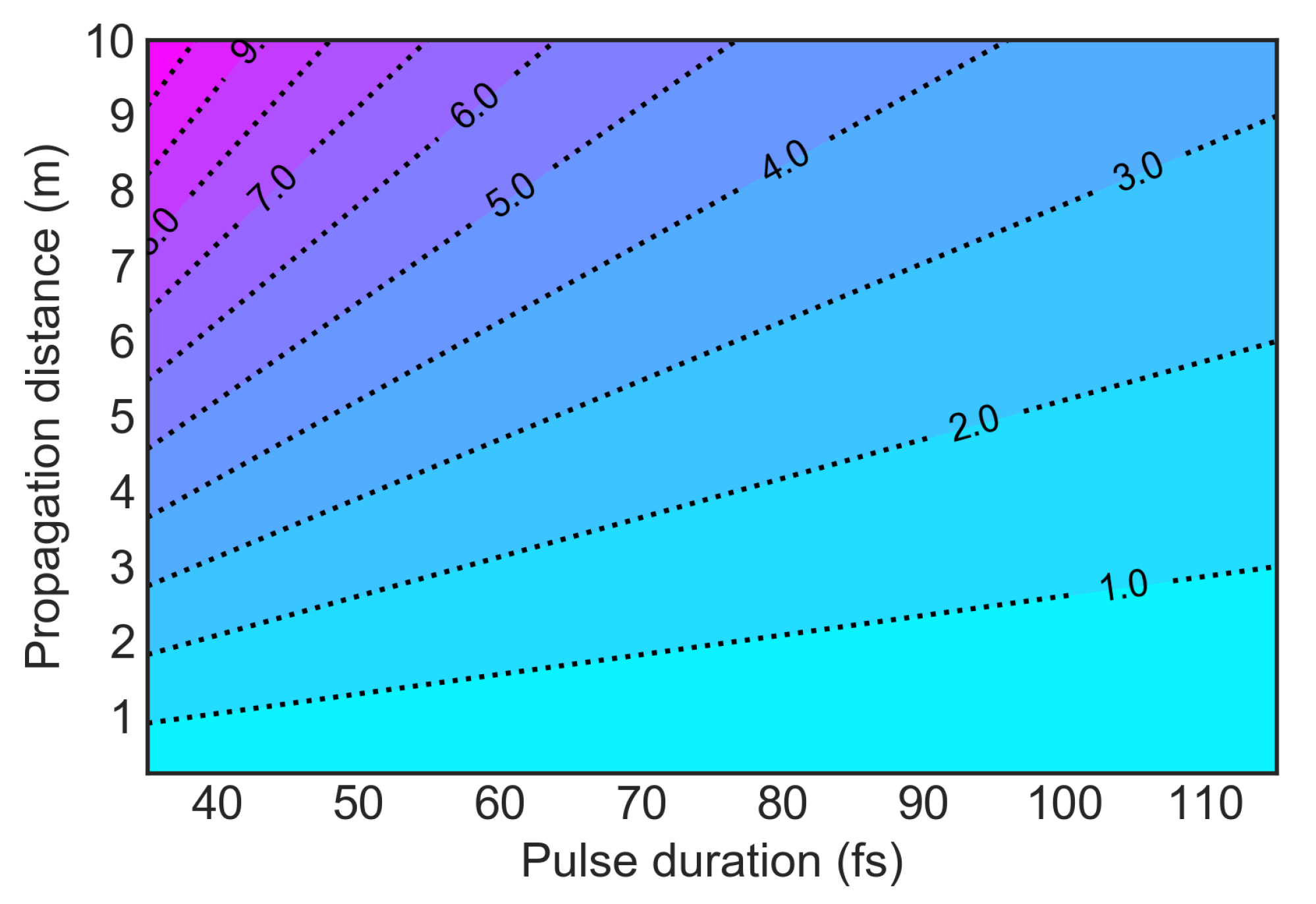
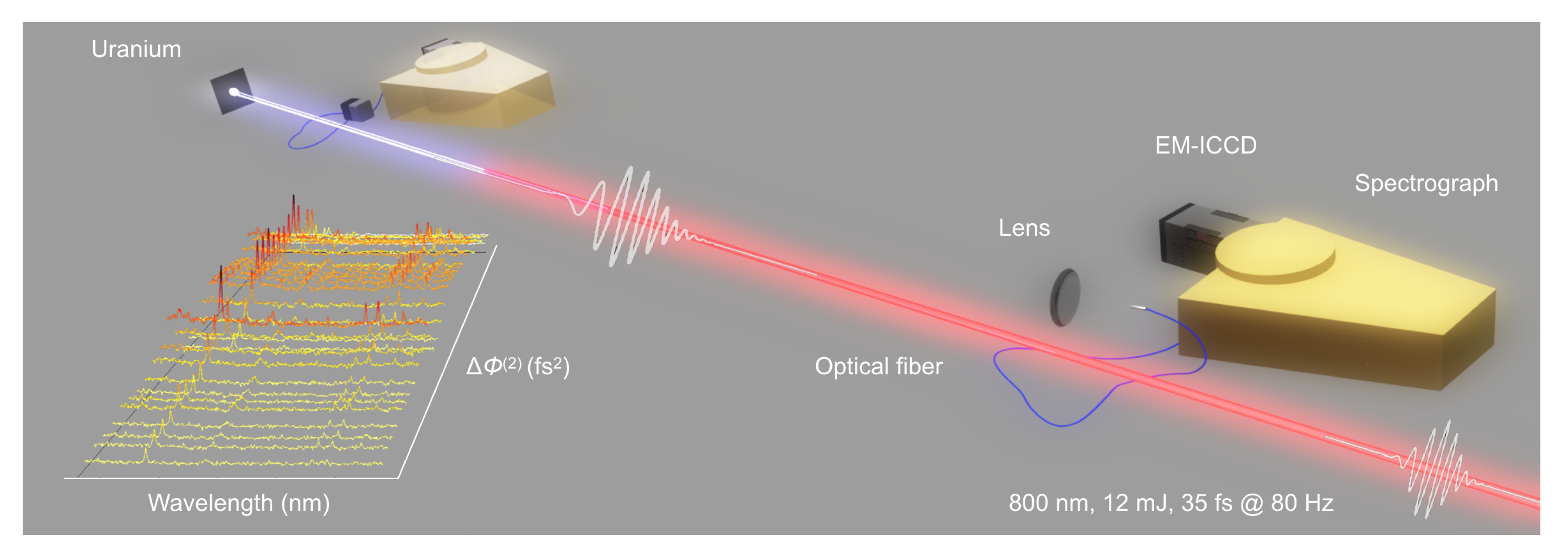
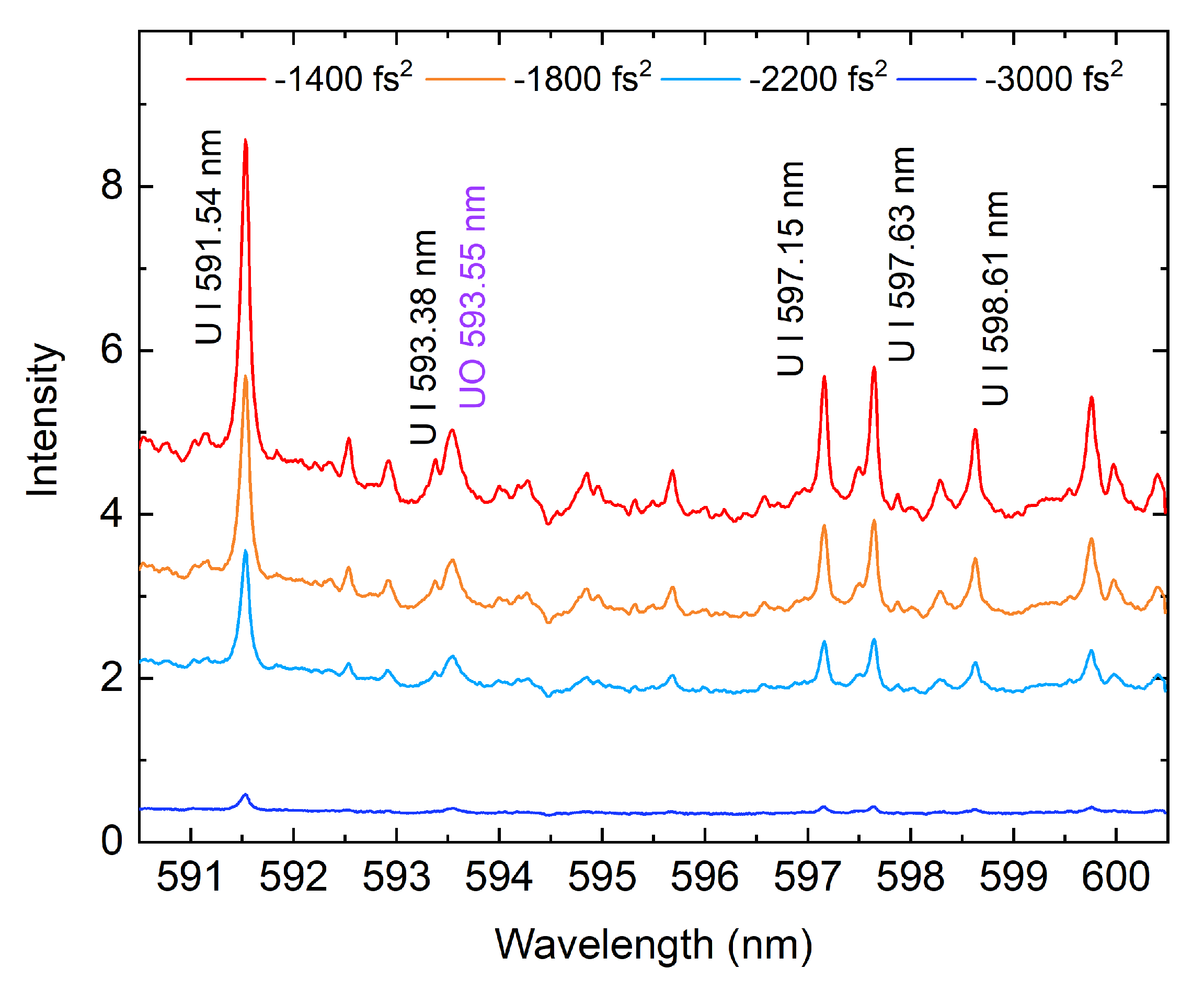
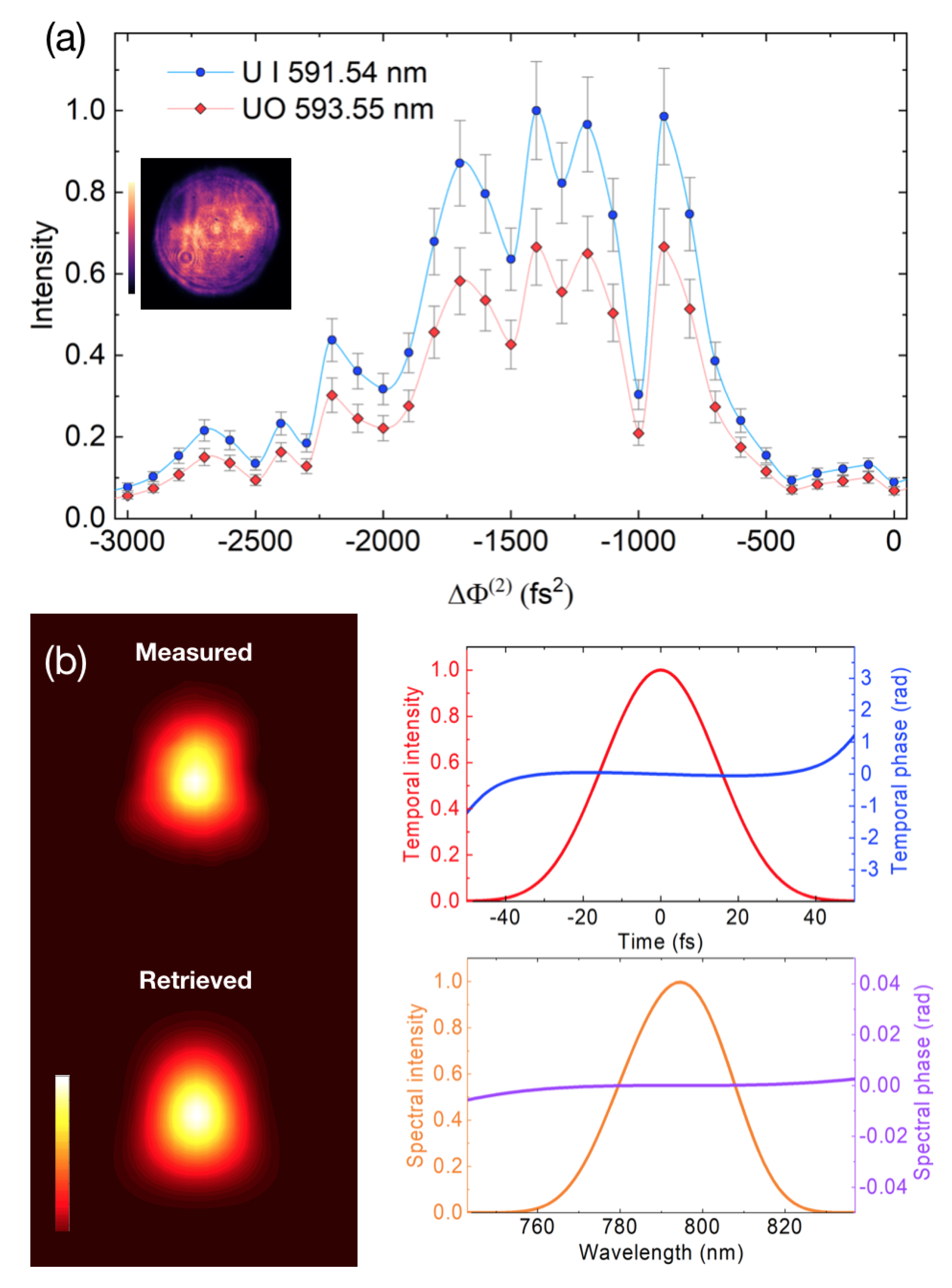

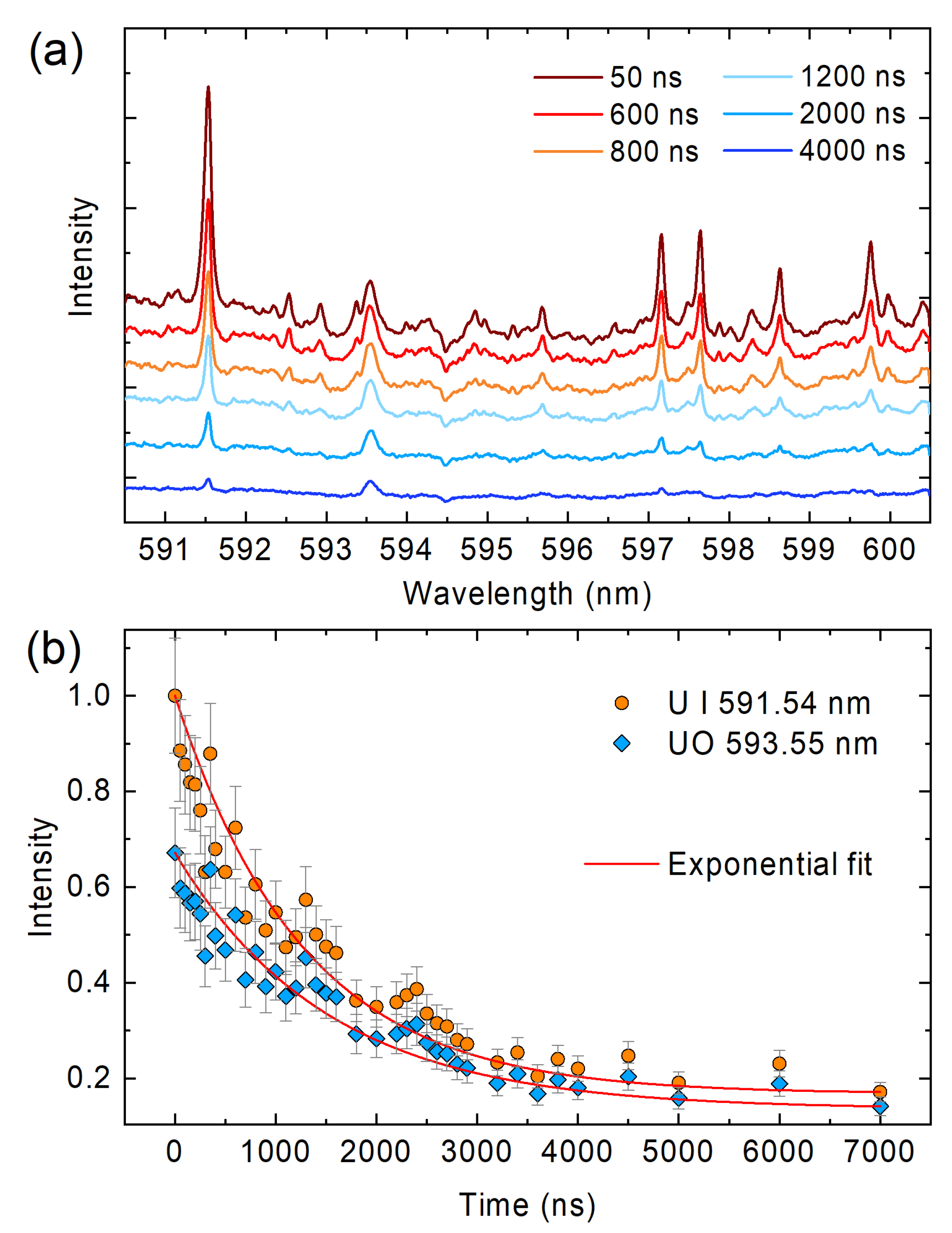
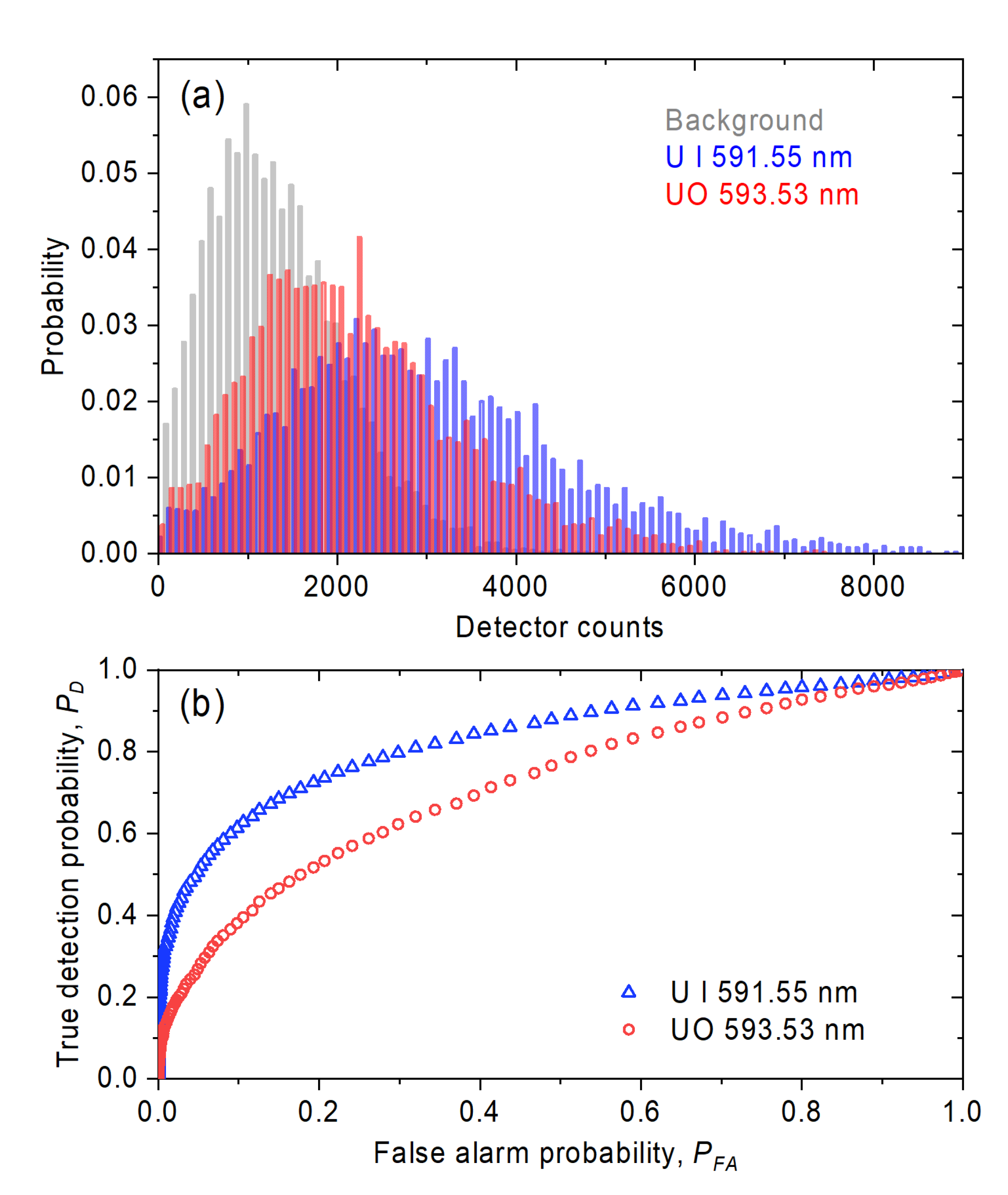
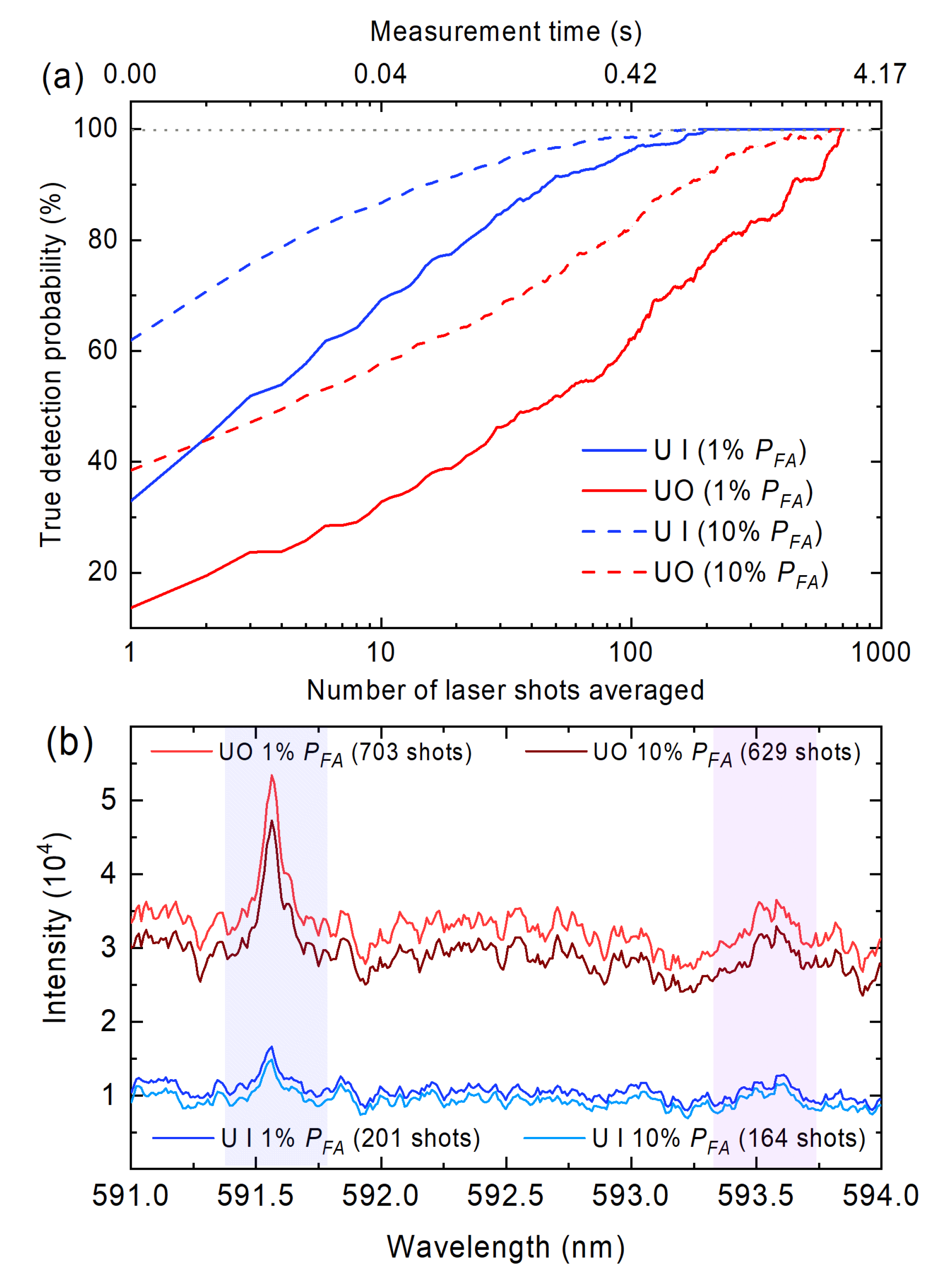
© 2020 by the authors. Licensee MDPI, Basel, Switzerland. This article is an open access article distributed under the terms and conditions of the Creative Commons Attribution (CC BY) license (http://creativecommons.org/licenses/by/4.0/).
Share and Cite
Burger, M.; Skrodzki, P.J.; Finney, L.A.; Nees, J.; Jovanovic, I. Remote Detection of Uranium Using Self-Focusing Intense Femtosecond Laser Pulses. Remote Sens. 2020, 12, 1281. https://doi.org/10.3390/rs12081281
Burger M, Skrodzki PJ, Finney LA, Nees J, Jovanovic I. Remote Detection of Uranium Using Self-Focusing Intense Femtosecond Laser Pulses. Remote Sensing. 2020; 12(8):1281. https://doi.org/10.3390/rs12081281
Chicago/Turabian StyleBurger, Miloš, Patrick J. Skrodzki, Lauren A. Finney, John Nees, and Igor Jovanovic. 2020. "Remote Detection of Uranium Using Self-Focusing Intense Femtosecond Laser Pulses" Remote Sensing 12, no. 8: 1281. https://doi.org/10.3390/rs12081281
APA StyleBurger, M., Skrodzki, P. J., Finney, L. A., Nees, J., & Jovanovic, I. (2020). Remote Detection of Uranium Using Self-Focusing Intense Femtosecond Laser Pulses. Remote Sensing, 12(8), 1281. https://doi.org/10.3390/rs12081281





